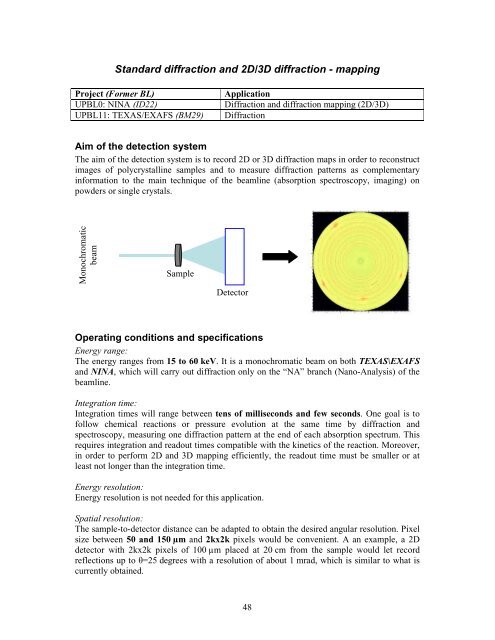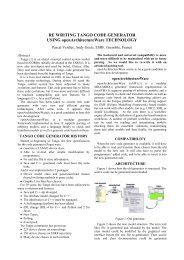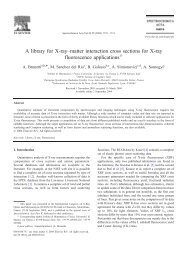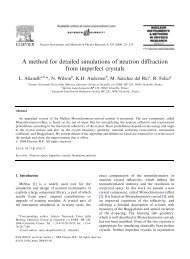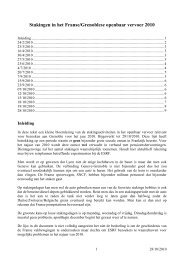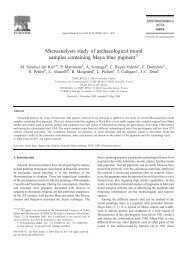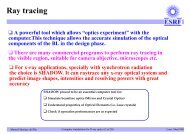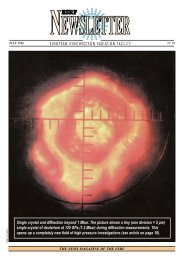Report on future detector requirements at ESRF
Report on future detector requirements at ESRF
Report on future detector requirements at ESRF
You also want an ePaper? Increase the reach of your titles
YUMPU automatically turns print PDFs into web optimized ePapers that Google loves.
Standard diffracti<strong>on</strong> and 2D/3D diffracti<strong>on</strong> - mapping<br />
Project (Former BL) Applic<strong>at</strong>i<strong>on</strong><br />
UPBL0: NINA (ID22) Diffracti<strong>on</strong> and diffracti<strong>on</strong> mapping (2D/3D)<br />
UPBL11: TEXAS/EXAFS (BM29) Diffracti<strong>on</strong><br />
Aim of the detecti<strong>on</strong> system<br />
The aim of the detecti<strong>on</strong> system is to record 2D or 3D diffracti<strong>on</strong> maps in order to rec<strong>on</strong>struct<br />
images of polycrystalline samples and to measure diffracti<strong>on</strong> p<strong>at</strong>terns as complementary<br />
inform<strong>at</strong>i<strong>on</strong> to the main technique of the beamline (absorpti<strong>on</strong> spectroscopy, imaging) <strong>on</strong><br />
powders or single crystals.<br />
M<strong>on</strong>ochrom<strong>at</strong>ic<br />
beam<br />
Sample<br />
Detector<br />
Oper<strong>at</strong>ing c<strong>on</strong>diti<strong>on</strong>s and specific<strong>at</strong>i<strong>on</strong>s<br />
Energy range:<br />
The energy ranges from 15 to 60 keV. It is a m<strong>on</strong>ochrom<strong>at</strong>ic beam <strong>on</strong> both TEXAS\EXAFS<br />
and NINA, which will carry out diffracti<strong>on</strong> <strong>on</strong>ly <strong>on</strong> the “NA” branch (Nano-Analysis) of the<br />
beamline.<br />
Integr<strong>at</strong>i<strong>on</strong> time:<br />
Integr<strong>at</strong>i<strong>on</strong> times will range between tens of millisec<strong>on</strong>ds and few sec<strong>on</strong>ds. One goal is to<br />
follow chemical reacti<strong>on</strong>s or pressure evoluti<strong>on</strong> <strong>at</strong> the same time by diffracti<strong>on</strong> and<br />
spectroscopy, measuring <strong>on</strong>e diffracti<strong>on</strong> p<strong>at</strong>tern <strong>at</strong> the end of each absorpti<strong>on</strong> spectrum. This<br />
requires integr<strong>at</strong>i<strong>on</strong> and readout times comp<strong>at</strong>ible with the kinetics of the reacti<strong>on</strong>. Moreover,<br />
in order to perform 2D and 3D mapping efficiently, the readout time must be smaller or <strong>at</strong><br />
least not l<strong>on</strong>ger than the integr<strong>at</strong>i<strong>on</strong> time.<br />
Energy resoluti<strong>on</strong>:<br />
Energy resoluti<strong>on</strong> is not needed for this applic<strong>at</strong>i<strong>on</strong>.<br />
Sp<strong>at</strong>ial resoluti<strong>on</strong>:<br />
The sample-to-<strong>detector</strong> distance can be adapted to obtain the desired angular resoluti<strong>on</strong>. Pixel<br />
size between 50 and 150 µm and 2kx2k pixels would be c<strong>on</strong>venient. A an example, a 2D<br />
<strong>detector</strong> with 2kx2k pixels of 100 µm placed <strong>at</strong> 20 cm from the sample would let record<br />
reflecti<strong>on</strong>s up to θ=25 degrees with a resoluti<strong>on</strong> of about 1 mrad, which is similar to wh<strong>at</strong> is<br />
currently obtained.<br />
48


